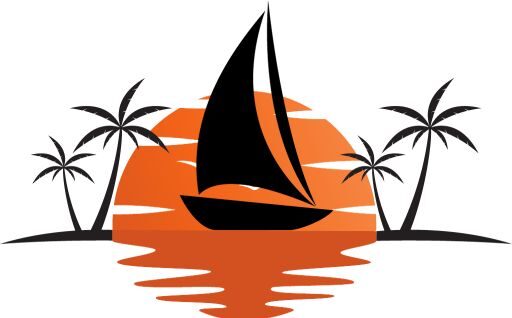Sail From Florida To The Bahamas – Things You Need To Know
Sail on Sunshine contains affiliate links. If you make a purchase using one of these links, we may receive compensation at no extra cost to you. We only recommend products and services we use and trust. Read our disclaimer for more information.
Looking for guidance on the logistics and timing to sail from Florida to the Bahamas? Look no further! This comprehensive guide is packed with invaluable advice and essential preparations from first-hand experience. Start planning today!
Sail From Florida To The Bahamas
Each year, numerous boats set out on the passage from Florida to the Bahamas. The Bahamas ranks among the world’s premier cruising destinations. With its smooth sailing conditions, gin-clear waters, and never-ending pockets of white sandy beaches, it’s hard to resist the allure of the Bahamas. Our family has enjoyed multiple winter seasons cruising in this stunning archipelago, and it never fails to leave us in awe.
How To Sail To The Bahamas

Sailing from Florida to the Bahamas can be an exciting and rewarding adventure. It can also be uncomfortable and scary, especially your first time. Here are the general categories you need to have knowledge of to sail to the Bahamas:
- Preparation and Planning – vessel system checks, provisioning, route planning, weather.
- Navigation and Seamanship – learning how to read charts, piloting, knowing your vessel, and the rules of the road.
- Navigating the Gulf Stream – learn how to cross the Gulf Stream in comfort and safety.
- Clear Customs and Immigration – process, paperwork, and fees
- Safety and Communication – emergency drills, gear and VHF
- Anchoring – learn how to safely anchor your vessel
- Local Knowledge and Resources – ask other cruisers! They’ve done it.
Is It Easy To Sail From Florida To The Bahamas?
While sailing from Florida to the Bahamas is a well-traveled route, it is not necessarily “easy.” It requires planning, preparation, and experience to ensure a safe and uneventful passage.
On our first crossing, we were a bit nervous and ended up going an unconventional route. Sailing 28 hours overnight from Marathon all the way across the Little Bahama Bank to Bird Cay in the Berry Islands. Honestly, we got a bit tired of waiting in Marathon for 3 weeks!
So we ventured out on a decent forecast and of course, the winds ended up switching and the Gulf Stream crossing was pretty rough though we never felt in danger. It was a tiring long sail. If you are new to offshore sailing or unfamiliar with the area, it’s advisable to gain experience and possibly join an experienced crew or flotilla for your first trip.
Tip: Don’t do an overnight your first crossing. The distances can look short on the chart but take it easy, sail the shortest daytime route possible.
What Size Boat Do You Need To Sail From Florida To Bahamas?
Need? Well, that’s a matter of personal preference and depends on the number of people aboard and your comfort level. As long as the boat is seaworthy, size may not be the most crucial factor. In our case, as a family of four, we didn’t consider boats under 40 feet. However, for a solo sailor, a 25-foot vessel could be entirely adequate. Larger boats offer faster sailing and more interior space, while smaller boats are easier to handle and less expensive to maintain.
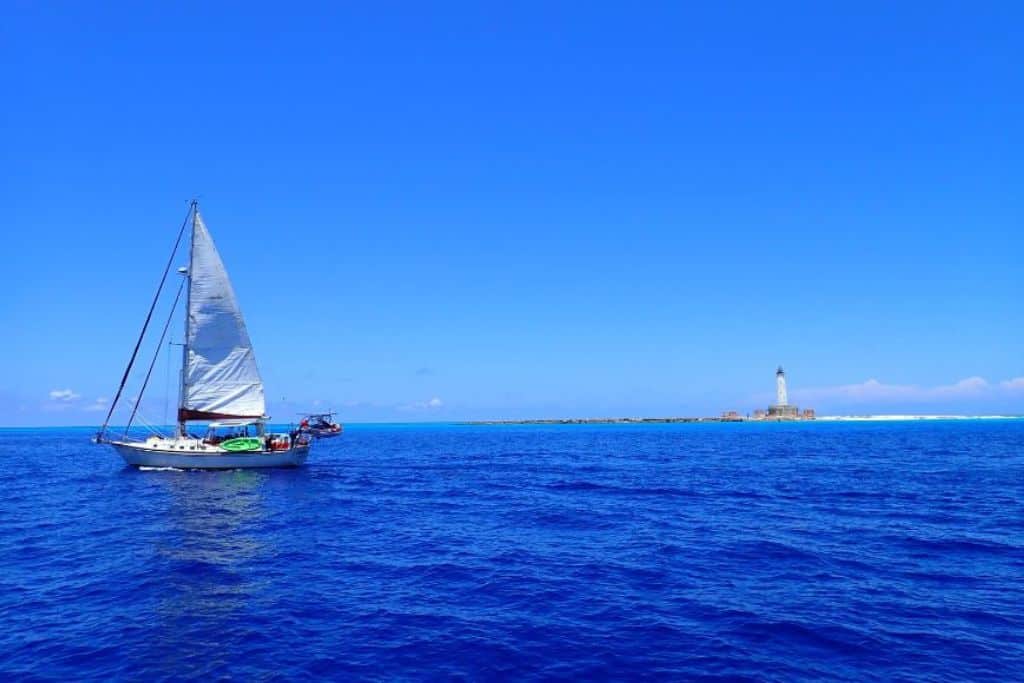
Best Time To Sail From Florida To Bahamas
The best time to sail from Florida to the Bahamas is winter to early spring, specifically late October to April. This is due to several factors:
- Weather: Winter and early spring bring mild temperatures, lower humidity, and reduced chances of hurricanes or tropical storms compared to the summer months.
- Winds: During the winter and early spring, prevailing winds from the northeast and east provide reliable sailing conditions in the Bahamas.
- Water Clarity: The Bahamas is known for excellent water visibility and ideal snorkeling and diving conditions. I can attest to the water clarity, sometimes it blows my mind and I just stare at the bottom going by.

Distance From Florida To Bahamas
The Bahamas lie just 45 to 55 nautical miles off the Florida coast depending on your departure point and destination. This is one of the reasons it is such a popular destination from the United States. The shortest distance is between Miami and Bimini at roughly 45 nautical miles. Factors such as weather and current may affect the route and therefore overall distance sailed.
Which Routes And Departure Locations Are Frequently Used?
Departure Locations
The two most used departure locations are Lake Worth Inlet (West Palm) and No Name Harbor south of Miami. These points set you up nicely to leverage the Gulf Stream to your advantage, or at least minimize its potential disadvantages. Both are great jumping-off spots depending on your destination.
Routes
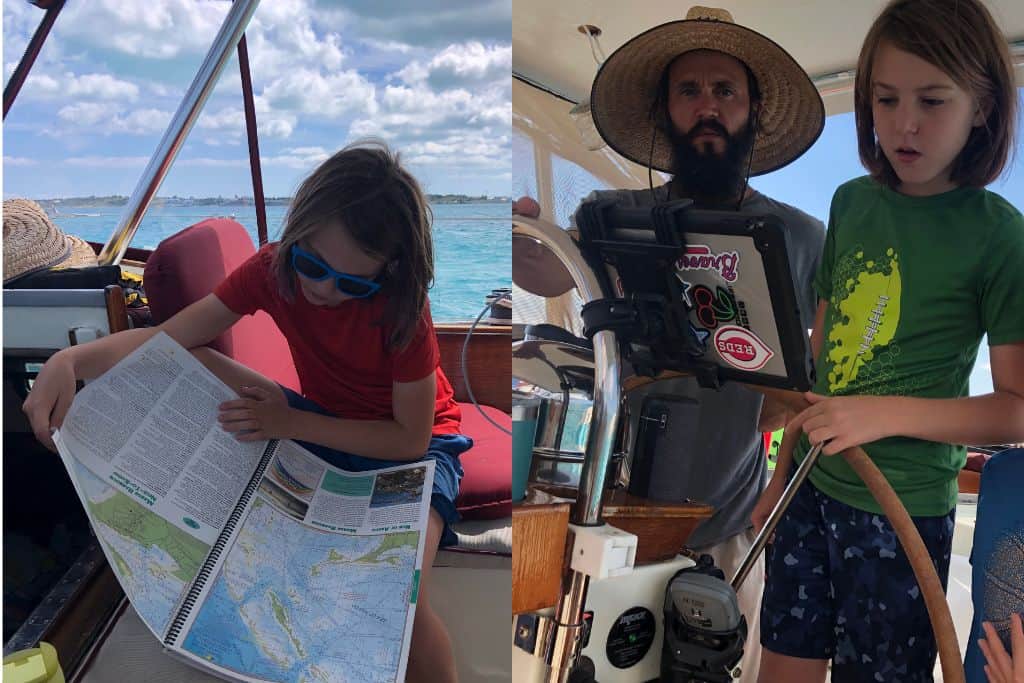
You will need a few tools for route planning, we personally standby Navionics downloaded to our tablet and phone as well as Explorer Chartbooks. The Navionics app is easy to use with good charts. The highly accurate Explorer Chartbooks are a must-have and have proved to be invaluable when paired with the use of Navionics.
We also use Garmin BlueCharts on our MFD (multi-functional device) to cross-reference. Have we mentioned our captain loves charts and redundancies?
Lake Worth To The Abacos
This route is a good choice for several reasons. First, you can set a course due east and reach West End, or extend your passage onto the banks to reach Mangrove Cay by dusk. The Lake Worth Inlet is also easily navigatable being wide and deep with well-lit aids to navigation. In addition, the anchorage is large so there’s always space allowing you to wait for favorable weather conditions.
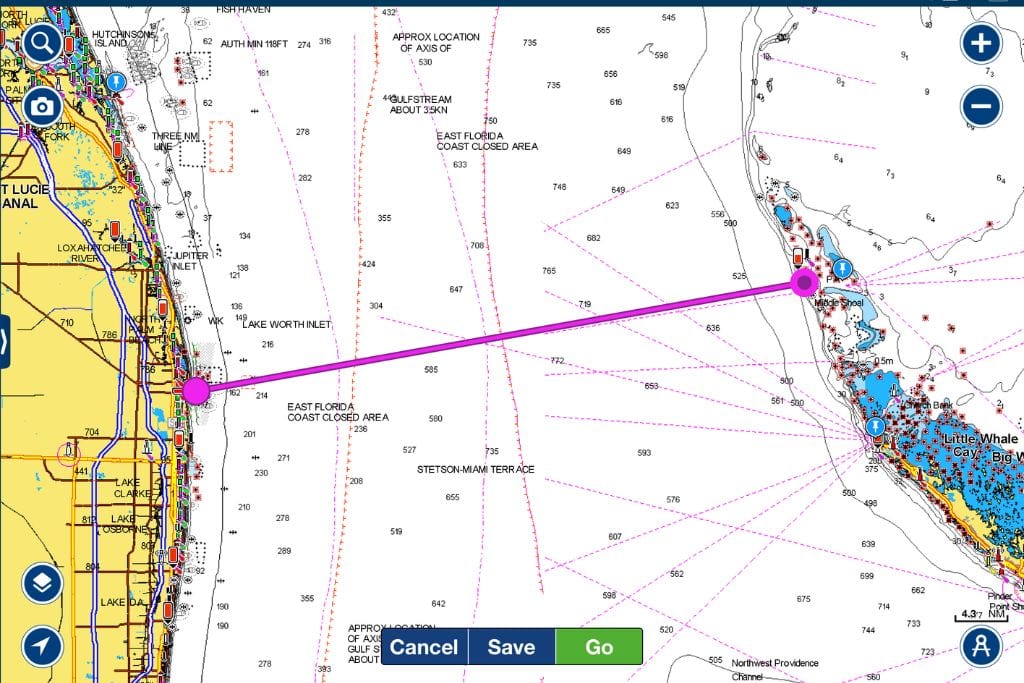
We have personally done this trip leaving pre-dawn and arriving at Mangrove Cay at dusk. If the stuff hits the fan you can always bail out at West End although I wouldn’t recommend going into the breakwater after dark (we speak from experience!). The entrance is narrow and has a 90-degree turn to starboard once inside the jetty as you can see in the picture below.
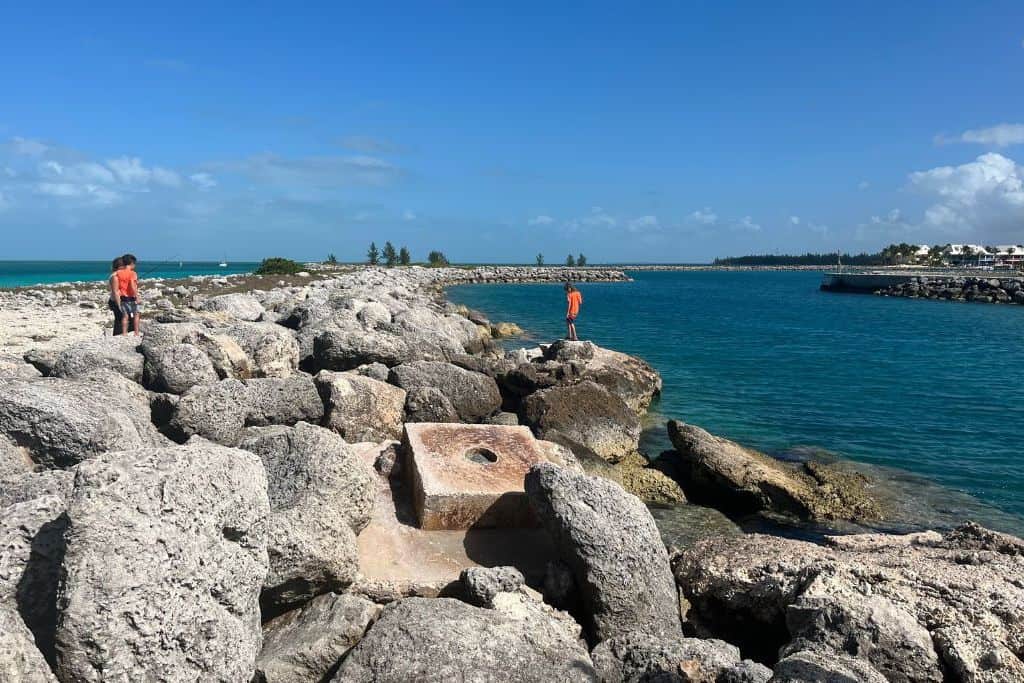
We actually did bail out and go to West End on our second crossing to the Bahamas in 2021. The captain and kids were seasick and the chief mate was not up for continuing on her own through the night so it was an absolute save to have the option. There is also an anchorage on the outside if the conditions are favorable, likely a better option if it’s dark.
No Name Harbor (Miami) To Bimini
No Name Harbor sits on the south end of Key Biscayne near the Cape Florida lighthouse. This is a popular route due to its protected staging area and proximity to Bimini at roughly 45 nautical miles, making this a quick day sail for most vessels. There are also several marinas in Bimini for clearing in.
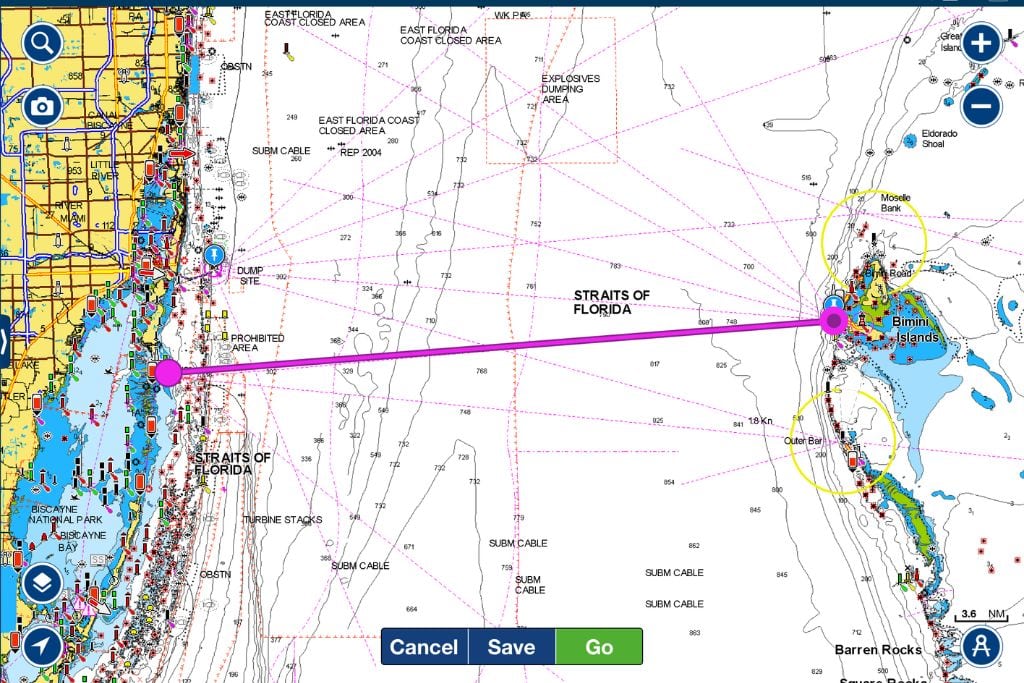
How Long Does It Take To Sail From Florida To Bahamas?
Yes yes, how long is a piece of string? If we are talking about the shortest route from No Name Harbor to Bimini which is about 47 nautical miles, then roughly 9.5 hours. This is for the average sailboat (like ours) moving at 5-6 knots. I do all our voyage planning at 5 knots for better or worse.
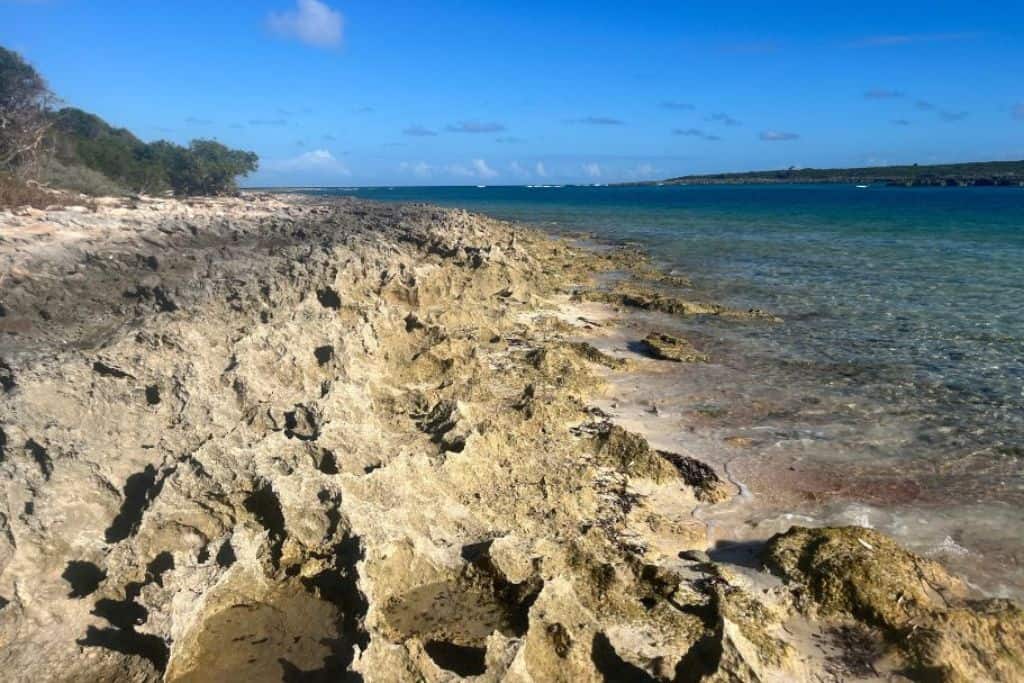
Below are some popular routes, distances, and times:
All distances and times are approximate based on average 5 knots speed. Your mileage may vary.
- No Name Harbor to Great Harbor Cay, Berry Islands
- 135 nautical miles, 26 hours
- No Name Harbor to Bimini
- 45 nautical miles, 9 hours
- No Name Harbor to Lucaya, Grand Bahama
- 96 nautical miles, 19 hours
- Lake Worth to West End, Grand Bahama
- 55 nautical miles, 11 hours
- Lake Worth to Green Turtle Cay, Abacos
- 150 nautical miles, 30 hours
Given that we’re at the mercy of Mother Nature, we prefer to err on the side of caution and allocate more time for our crossing. Considering the shorter daylight hours in winter, we typically set sail pre-dawn to ensure we have ample time to arrive in daylight.
Navigating The Gulf Stream
What Is The Gulf Stream?
The Gulf Stream is one of the world’s major currents that flows like a river between Florida and the Bahamas. As you can see below this warm water is being pushed up from the Gulf of Mexico and Caribbean Sea North along the coast of Florida and into the North Atlantic Ocean.
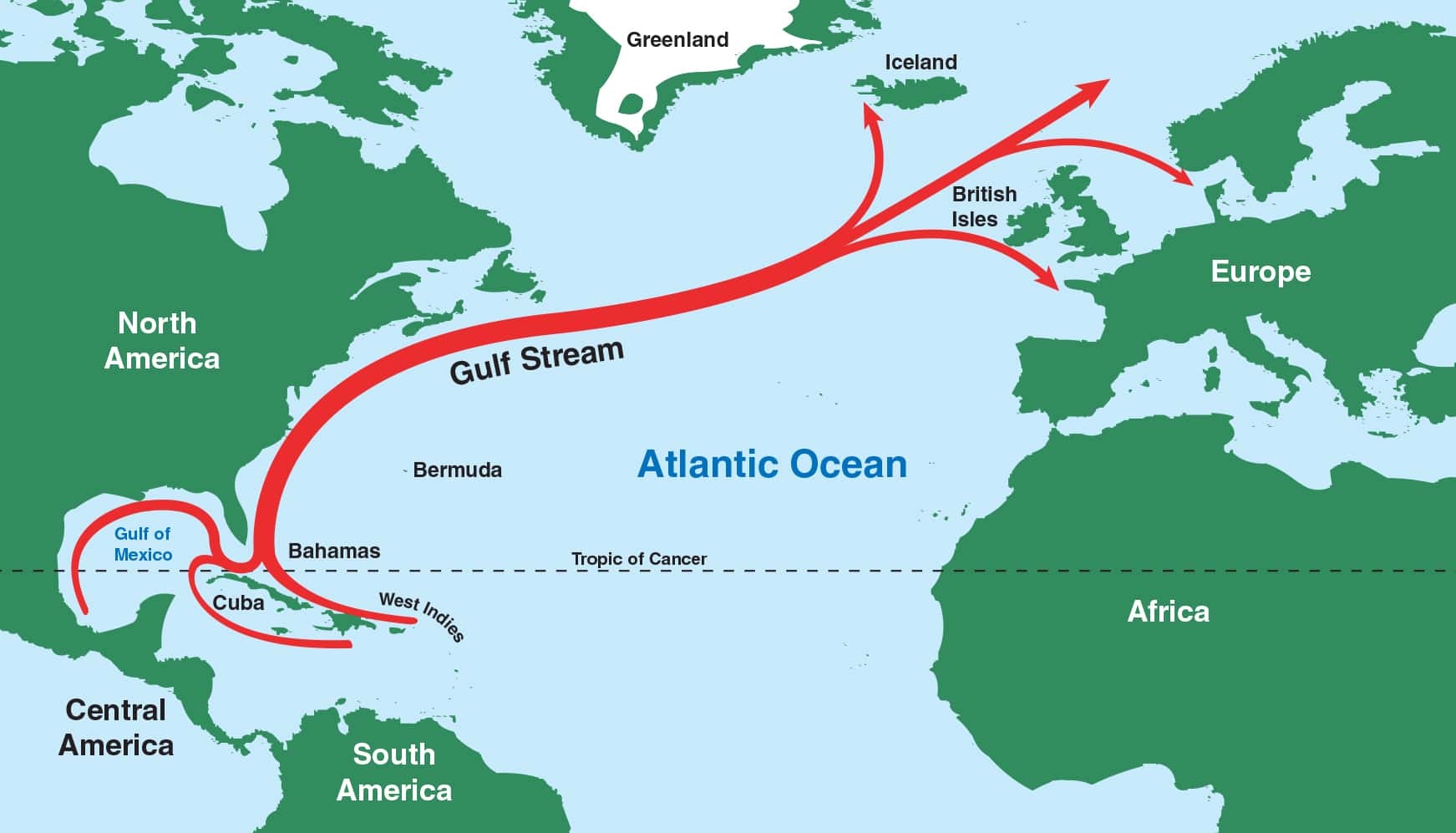
As depicted in the image below, the Gulf Stream stands as a formidable barrier between you and the captivating Bahama Blues. This powerful current flows at an average rate of approximately 3.5 knots, with a maximum speed reaching about 4.8 knots. Undoubtedly, it’s a factor that should be considered in your planning. However, it’s normally around 2.5 knots off of Florida.
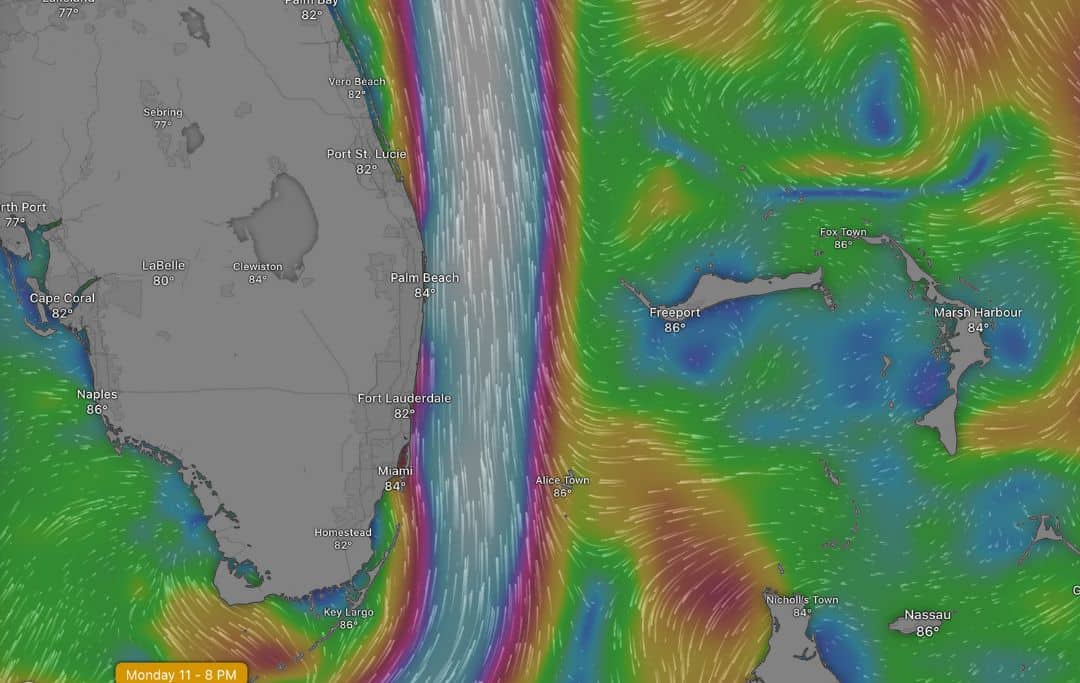
Rule #1 (At Least Our #1)
Never sail from Florida to the Bahamas when a North Wind of any significance is forecast. We say “significant” because if it’s blowing all of 2 knots then it’s a moot point. Anything forecast over 5 knots is a no-go for us and really we just wait for no Northern wind component.
The rationale behind this is that you’ll have wind out of the North blowing South that is opposing the Gulf Stream heading North. Why is that important? This creates notably steep (wave height) and closely spaced (wave period) waves which can make things very uncomfortable and dangerous.
They stack up fast and the longer it blows the worse it gets. Through our experiences, we’ve found it prudent to add an additional 5 knots to the wind forecast and anticipate waves being 2 feet higher than the initially predicted wave height.
Rule #2
Don’t steer a course South of East. Any course greater than 090 degrees you will be fighting the Gulf Stream and slow you down. If you need to steer less than 090 degrees by all means do so, you’ll get a boost from the Gulf Stream.
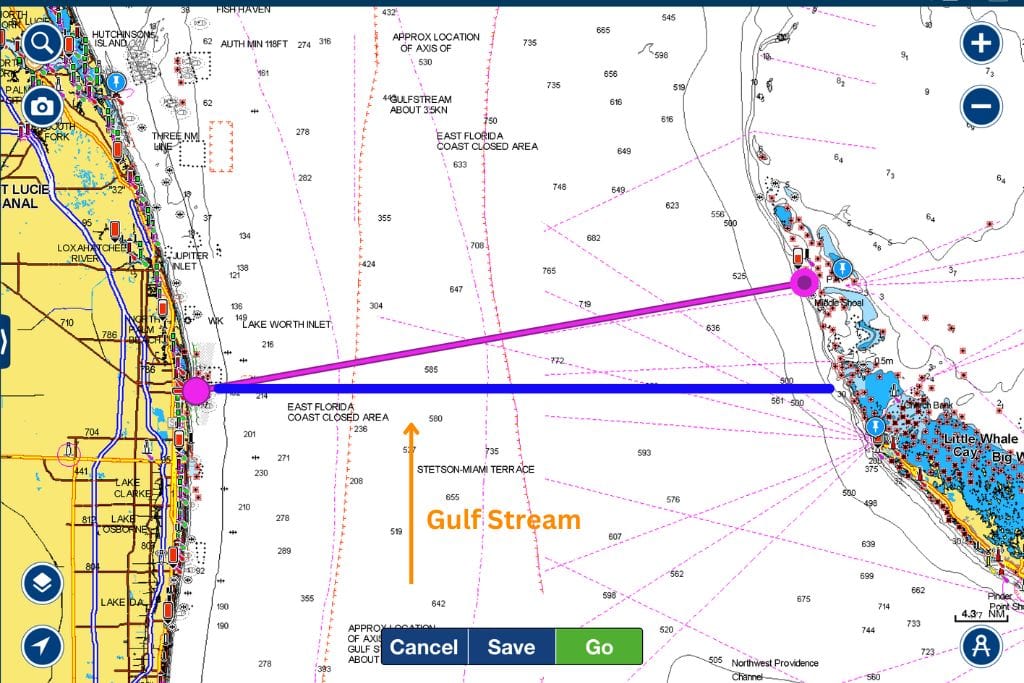
Here is the rhumb line between Lake Worth and Memory Rock. If you steered the magenta course you would end up North of your intended destination with the push of the gulf stream setting you North. However, by steering the blue course line of 090 degrees you use the Gulf Stream to help you to your endpoint.
Weather
Cold Fronts (Can Be Your Friend)
How can cold fronts be your friend? During the winter months cold fronts associated with low pressures roll off the East Coast of the United States regularly. These fronts sweep down to Florida and cause the winds to veer or change direction in a clockwise fashion.
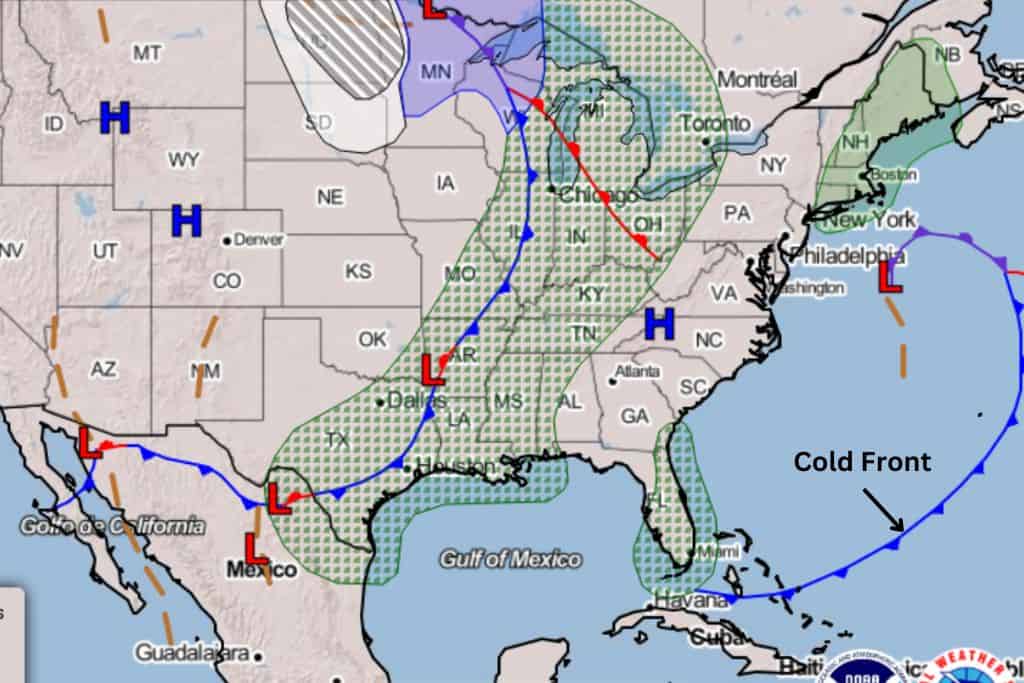
Typically, the prevailing winds come from the east and that’s the way you want to go. After the front passes, you can expect the winds to first shift south, then west, followed by north, and eventually return to the east. Departure is best timed once the winds shift to the South East.
Keep in mind that exact timing can also depend on your specific departure location in Florida and your intended destination in the Bahamas. Always check local weather forecasts and navigation charts before setting sail.
Thunderstorms (Not Really Your Friend)
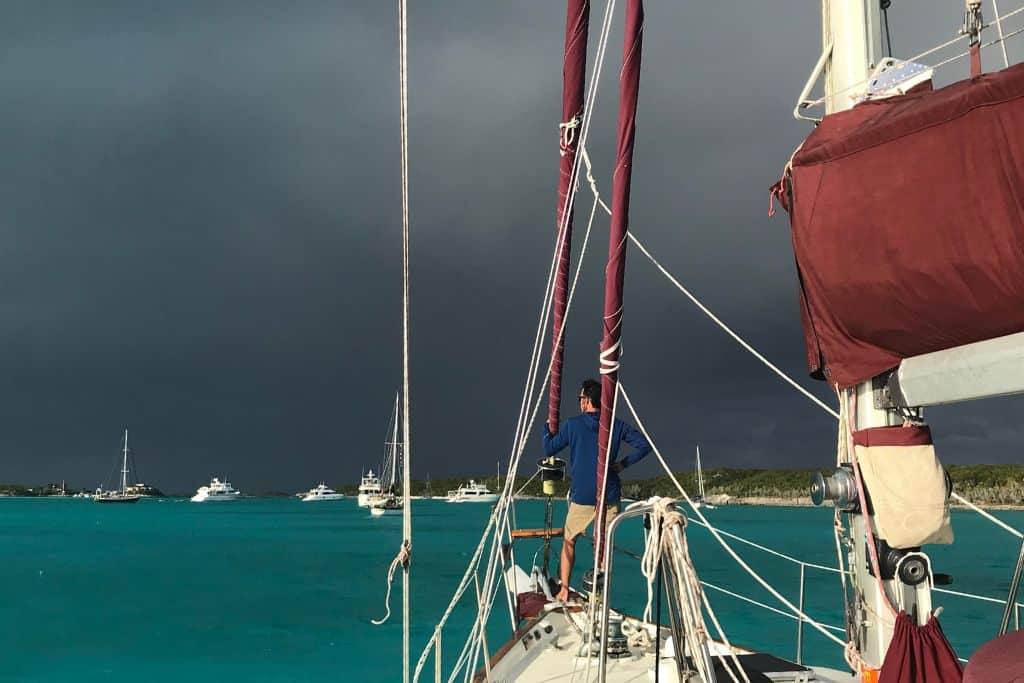
As the season progresses, thunderstorms tend to decrease in frequency, but sailors always closely monitor the weather, as it significantly influences our decisions and actions. We have been through a number of these both at anchor and underway. They can be scary and intense, with heavy rainfall and strong gusty winds, yet they often pass relatively quickly.
Being prepared is our best defense. Securing the deck, changing course to avoid them, letting out more anchor rode, or moving to a more protected anchorage.
Hurricanes (Definitely Not Your Friend)
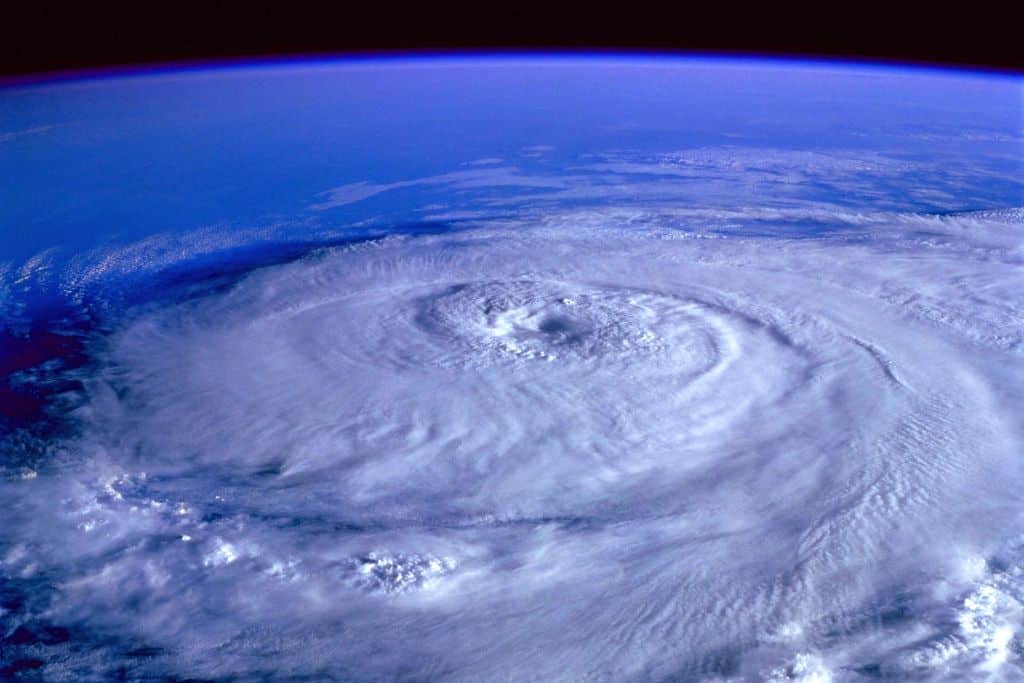
Hurricanes, also known as cyclones or typhoons in different parts of the world, are powerful tropical storms that form over warm ocean waters. These storms are categorized based on their wind speed, with categories 1 to 5.
- Category 1: 64-82 kt
- Category 2: 83-95 kt
- Category 3: 96-112 kt
- Category 4: 113-136 kt
- Category 5: 137 kt or higher
Needless to say, you don’t want to be in their way, especially in a boat. The best strategy here to avoid hurricanes is not to sail in the hurricane box during hurricane season which is June 1 to November 30.
When we leave our boat during hurricane season wherever it is we always monitor hurricane activity through NOAA National Hurricane Center.
Weather Forecasting Tools We Use
We’ve already mentioned how important weather forecasting is so below is a list of forecasting tools we use and recommend. Get familiar with these before you sail from Florida to the Bahamas or anywhere for that matter. The weather really does rule all when sailing!
Helpful Weather Tools For A Sail From Florida To The Bahamas
- PredictWind – Our everyday go-to app for checking wind and sea state forecasts in combination with the other sources mentioned below. We like its simplicity and the ability to scroll hour by hour quickly. There is a free version that you can try but we use the paid service with the basic plan ($29/Yr). You can upgrade further to get other features like departure planning and weather routing.
- Windy – Similar to PredictWind and using the same weather models but with a more elegant user interface. We use it primarily to view swell and weather radar. We like being able to view the whole week at a glance when you pick a specific location.
- Marine Weather Center If you are new to sailing you need to know about Chris Parker. He is a marine weather forecaster whom you can hire to provide personalized routing forecasts via email or SSB. You can also listen in for free if you have an SSB receiver like the one we use on Sunshine. On our first season to the Bahamas before Starlink, we would get up early to listen to his forecast.
- NOAA synoptic charts – We use this mainly for watching cold fronts and to get an overall picture of weather patterns. These charts are a little more archaic and take a bit of time to learn how to read but we use them as another source of information. Can’t have too many!
- National Weather Service Marine Forecasts – We use this mainly for the crossing to/from the Bahamas because it shows the zones crossing the Gulf Stream. This information is in text format with waves and wind and helps give you an idea of the sea state.
Optional Weather Tools
- PassageWeather – A free weather forecasting website for sailors. Uses the same forecasting models as the others.
- NHC Offshore Waters Forecasts – We didn’t rely on these as heavily for the crossing from Florida to the Bahamas, these are best for longer open-water passages. The ocean is broken down into zones, hover over the one you want. We used them for the passage from the Bahamas to the Dominican Republic and will also use them for the jump to Puerto Rico.
Are There Any Dangers?
Like any activity, there can be dangers associated with sailing but with planning and preparedness, you’ll be ready to tackle any situation that arises.
Emergencies
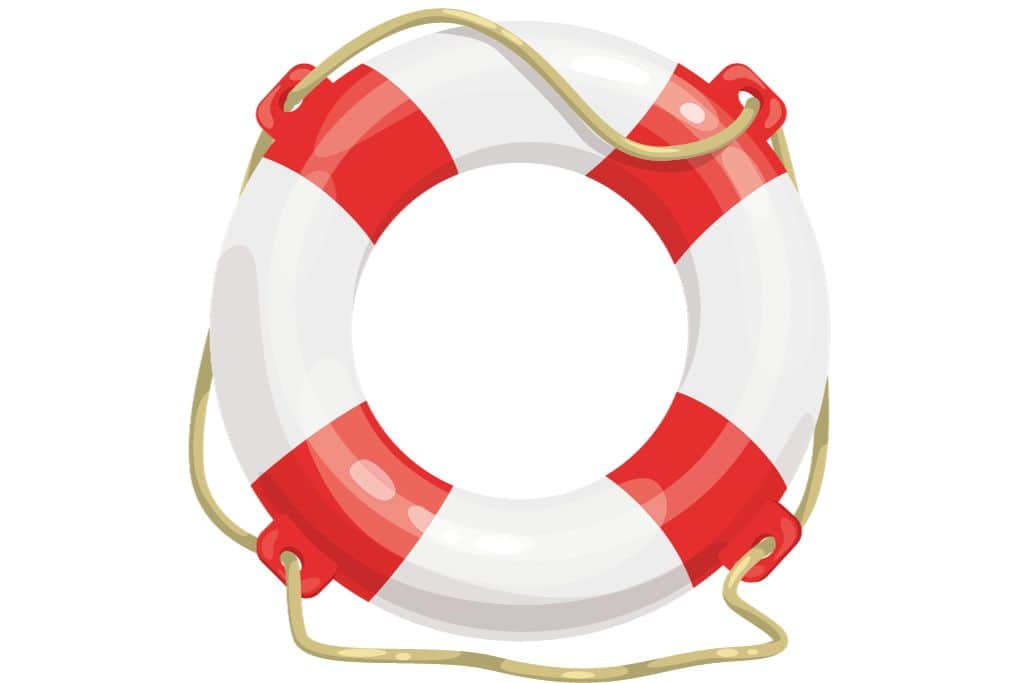
During a sail from Florida to the Bahamas, potential challenges may include dehydration, seasickness, sunburn, injuries, mechanical failures, water ingress, fires, or man overboard (MOB) incidents. To effectively address these potential obstacles, proper training is essential. Consider enrolling in some courses such as first aid, navigation, and diesel engines.
Also, ensure your vessel is seaworthy, and conduct regular drills with your crew to be well-prepared for any situation.
Vessel Traffic
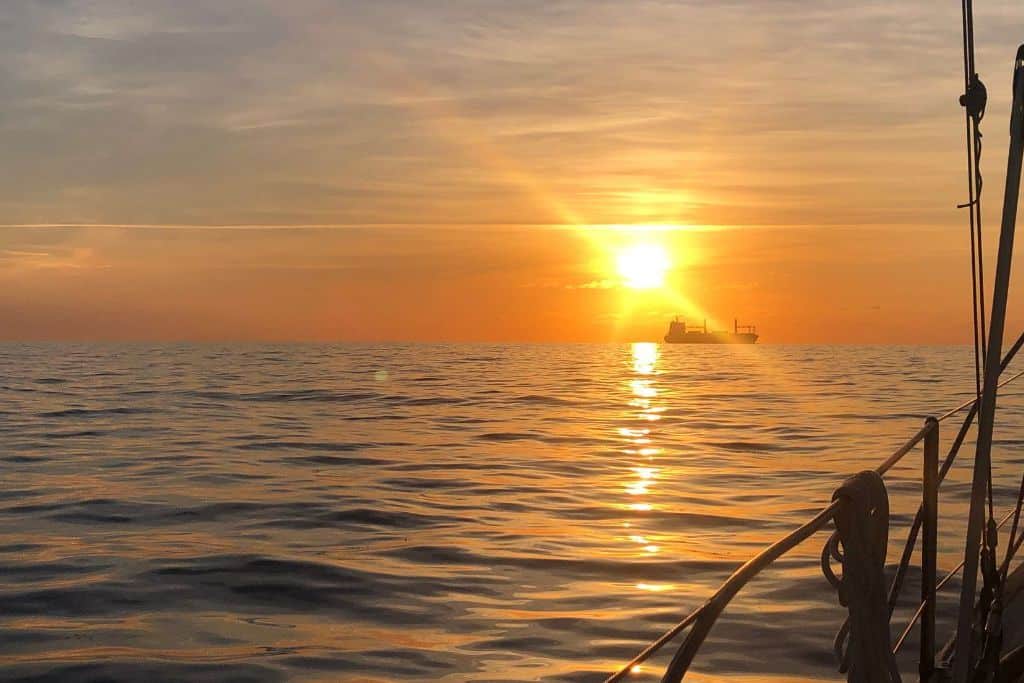
While you sail from Florida to the Bahamas, you’ll traverse a significant shipping route used by deep-draft vessels traveling back and forth from the East Coast to southern destinations. These large ships can reach speeds of up to 23 knots! Translated to “They can be on you really fast”.
To ensure safe navigation, we rely on visual observation, AIS (Automatic Identification System), VHF, and radar to track and monitor these maritime traffic targets. Our standing orders are to alert the off-watch crew member when the CPA (closest point of approach) is less than 1 nautical mile during the day and less than 2 nautical miles at night. It can never hurt to call the other vessel on VHF if your feeling uncomfortable, sometimes we just like to know they see us!
How To Be Prepared
Here are some resources including classes, books, and cruising coaches we trust to help you be as prepared as possible:
First Aid Preparedness For You And Your Crew
- Red Cross First Aid Courses – Get your crew certified in first aid, you never know when you’ll need it.
- Dan Boater – A great resource for preparing your Ditch Bag, procuring a robust first aid kit, and many additional safety related topics.
Learn How To: Sail, Anchor, Navigate, Dock, And Maintain A Sailing Vessel
- American Sailing Association – We took two sailing courses in Bellingham WA prior to setting sail and we would recommend these to anyone just starting out.
- Annapolis School of Seamanship – Very well known and established school with any course you could think of.
- Join a charter that focuses on teaching you how to sail and prepare for cruising. We recommend the following:
- Vagabond Adventures – Offers a couple of incredible packages to get you learning hands-on in the Bahamas. We met Captain Jack and he is one of the most humble guys you will meet and has a lot of cruising experience. Oh and did we mention you will cruise in style aboard Sailing La Vagabond’s Outremer Catamaran!
- Sailing Nadiya – We have been following their adventures on Instagram for a few years now and we are impressed by their charter offerings on a catamaran in the Bahamas. Just ask them to teach you the ropes and you can turn the charter into a dream learning opportunity.
- Sailing Britican – Learning the lifestyle in style! They offer week-long sailing experiences aboard a 50-foot catamaran in the Caribbean. Teaching you all the skills necessary to embrace this lifestyle on your own.
- Cruisers Acadamy – Providing learning sailing experiences from October to May in the Sea of Cortez. In addition, they offer a 4-day intro to sailing classes on Lake Tahoe.
- Hire a cruising consultant
- We recommend Pam Wall. She has cruised the world and has extensive experience sailing from Florida to the Bahamas.
- We also recommend Sailing Totem, an experienced cruising family that circumnavigated and offers coaching and many other resources to help you prepare.
- Check out a boat show – they typically offer a series of experienced speakers/sailors you can learn from and get inspired by. We met Pam Wall at the Seattle Boat Show years ago and just fell in love with her stories and information. It’s such a great way to experience a boat show. The big one is Cruisers University at the Annapolis sailboat show in October each year.
Travel Insurance & Emergency Evacuation Services
- Dan Boater – great for emergency evacuation services and more for as little as $60 per year ($100 for families) via their affordable membership. You can also buy travel insurance, but read the fine print. If you are a longer-term cruiser they have limitations on how long, etc.
- SafetyWing – SafetyWing offers both Medical and Travel Insurance check it out to see if you can get affordable coverage to meet your needs. We love how simple it is to get covered.
Boat Insurance
Boat insurance can be a thorn in your side, it’s a topic that comes up often. We hear and have experienced ourselves getting dropped each year, steep price increases, and policy changes requiring you to read the fine print.
- BoatUS – While cruising in US waters we can’t stress enough purchasing a membership with BoatUS. If you break down and need a tow this low-cost annual plan will save you thousands. We speak from experience!
- Insurance Brokers – We currently use Offshore Risk Management
Maintenance Books We Keep On Board
Nigel Calder’s Boatowners Mechanical and Electrical Manual
Don Casey’s Complete Illustrated Sailboat Maintenance Manual
Nigel Calder’s Marine Diesel Engines: Maintenance, Troubleshooting, and Repair
Clearing Into The Bahamas – What You Need
Clearing into the Bahamas by boat is a straightforward and necessary process for all international vessels upon arrival. This involves visiting a Bahamas port of entry and presenting your documents and paperwork.
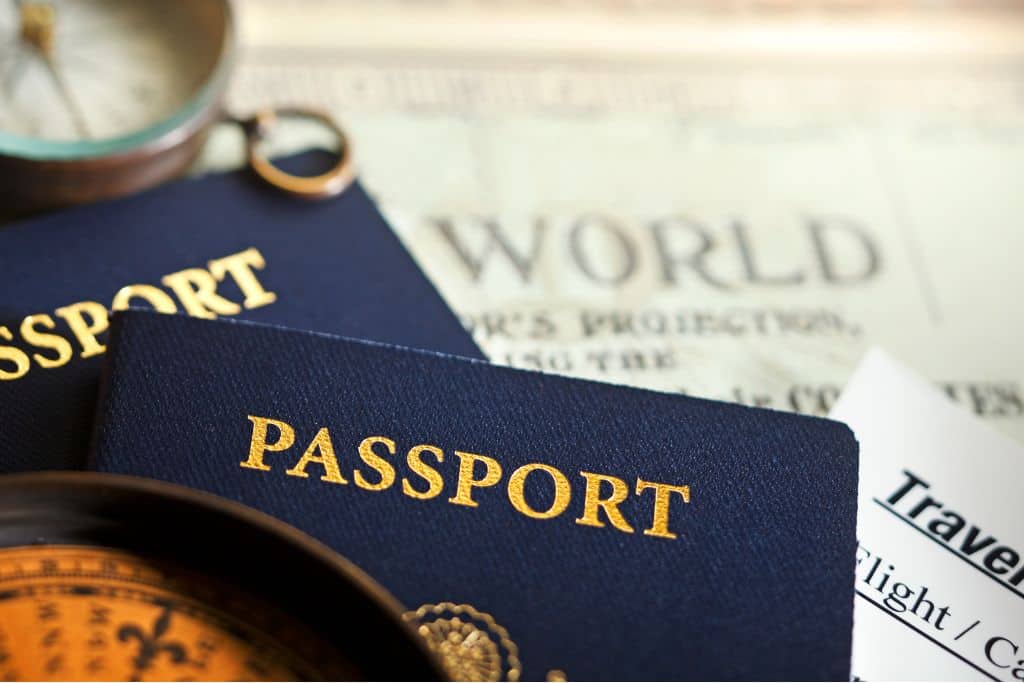
Things you’ll need:
- Quarantine flag – put up when you enter the country until you are officially checked in
- Bahamas courtesy flag – put up once you are checked in
- Passports for all crew members and passengers (expiry date no less than 6 months)
- Vessel documentation
- Completed Entry Paperwork
- Cash – Have some cash on hand just in case. With the new click2clear process, you should not need cash to check in but if you do at least you will be prepared and not have to spend time trying to find an ATM.
Process Click2Clear:
In 2021 the Bahamas began a digital submission process for clearing in called Click2Clear. I’ve found it a mixed bag, sometimes it works and sometimes it just adds confusion. But you can fill this out before you get there to expedite the process and pay the fees before you arrive. Below is a tutorial on how to get started on a cruising permit.
- From the home page click on “Cruising Permit”, it’s a blue button at the top
- On the next screen click on “Click Here To Log In”. Only red button
- Dont log in but instead click “Request Cruising Permit”
- Then click the drop-down on the left that says “Pleasure Craft” and click “Create Inbound”
- Then fill out all the sections, seven in total
Maybe it has improved but I have filled it out and submitted it only to have it not go through. Once you arrive the captain will need to visit the customs and immigration offices with passports for each person onboard as well as the vessel documentation. If you have issues don’t worry the customs and immigration officers will help you.
Once paperwork is completed and your fee is paid you’ll receive a temporary cruising permit that includes a fishing permit and allows you to explore Bahamian waters for 3 months. You have the option to stay longer than 3 months; however, you will pay a larger fee and other rules may apply.
Sailing The Bahamas On A Budget
You can surely sail from Florida to the Bahamas on a budget with these tips:
- Provision before you leave – Buy dried goods, paper goods, and beer in the States, as they are very expensive in the Bahamas. Also if you really like something, buy a lot of it.
- Anchor – Instead of going to a marina, anchor out…. it’s free!
- Limit eating out – Catch your own seafood and cook on the boat instead
- Limit paid excursions – Instead, enjoy free activities such as snorkeling, beach-combing, island hikes, cliff jumping, and more. Sailing is the excursion!
- Conserve fuel – Sail as much as possible to conserve diesel
- Do laundry onboard – The few spots on the islands to do laundry can be expensive
- Bring spare boat parts with you – It’s expensive to get items shipped to the Bahamas. Think about as many spares as possible and procure them before you leave.
- Pause your land-based subscriptions – Go through the list of subscriptions & services you won’t need while cruising and cancel or pause them until your return.
Conclusion: Sail From Florida To The Bahamas – Things You Need To Know
Sailing from Florida to the Bahamas offers an amazing and rewarding experience. It is a great place to start your first cruise with relatively easy sailing, beautiful weather, and plentiful anchorages. From small settlements to tranquil anchorages, the Bahamas’ gin-clear waters and sandy beaches invite us to immerse in a laid-back “island-time” culture. We can’t wait to go back and we hope that you have what you need to get there too! If you have any questions don’t hesitate to contact us.
